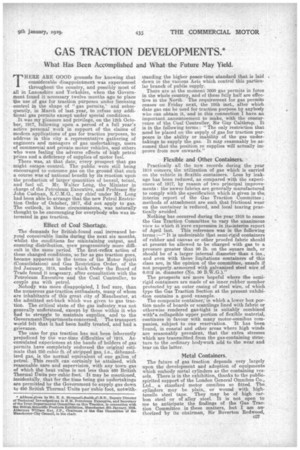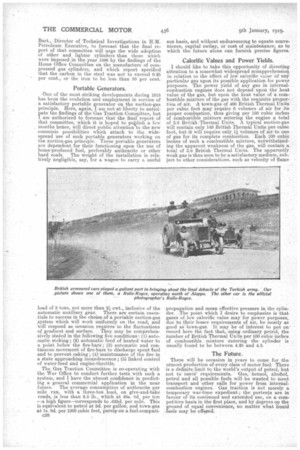GAS TRACTION DEVELOPMENTS.*
Page 17

Page 18

If you've noticed an error in this article please click here to report it so we can fix it.
What Has Been Accomplished and What the Future May yield.
THERE ARE GOOD grounds for knowing that considerable disappointment was experienced throughout the country, and possibly most of all in Lancashire and Yorkshire, when the Government found it necessary twelve months ago to place tjie use of gas for traction purposes. under licensing control in the shape of "gas permits,' and subsequently, in March of last year, to refuse any additional gas permits except under special conditions. It was my pleasure and privilege, on the 12th October, 1917, following upon a period of a full year's active personal work in support of the claims of modern applications of gas for traction purposes, to address in this city a representative gathering of engineers and managers of gas undertakings, users of commercial and private motor vehicles, and others who were feeling the adverse effects of high petrol prices and a deficiency of supplies of motor fuel.
Thera was, at that date, every prospect that as might escape control. The public were still being encouraged to consume gas on the ground that such a course was of national benefit by its reaction upon the production of larger quantities of benzol, toiuol, and fuel oil. Mr. Walter Long, the Minister in charge of the Petroleum Executive, and Professor Sir John Cadman, K.C.M.G., my chief under Mr. Long had been able to arrange that the new Petrol Restriction Order of October, 1917, did not apply to gas. The outlook, in these circumstances, was naturally. thought to be encouraging for everybody who was interested in gas traction.
Effect of Coal Shortage.
The demands for British-found coal increased beyond conceivable limits during the next six months, whilst the conditions for maintaining output, and ensuring distribution, grew progressively more difficult in the same period. The first reflex action of these changed conditions, so far as gas traction goes, became apparent in the terms of the Motor Spirit (Consolidation) and Gas Restriction Order, of the 3rd January, 1918, under which Order the Board of Trade found it nevssary, after consultation with the Petroleum • Executive and the Coal Controller, to couple gas with petrol.
Nobody was more disappointed, I feel sure, than the numerous gas-traction enthusiasts, many of whom are inhabitants of this great city of Manchester, at the admitted setback which was given to gas traction. The critical state of the gas industry was not generally understood, except by those within it who had to struggle to maintain supplies, and to the Government Departments, concerned. The transport world felt that it had been badly treated, and had a.
grievance. .
The case for gas traction has not been inherently prejudiced by the war-time difficulties of 1918. Accumulated experiences at the hands of holders of gas permits have completely endorsed the original estimate that 250 cubic ft. of stripped as i.e., debenzolized gas, is the normal equivalent of one gallon, of petrol. This result can .certainly be attained, with reasonable care and supervision, with any town gas of which the heat value is not less than 460 British Thermal Units per cubic foot It may be mentioned, incidentally, that for the time being gas undertakings are permitted by the Government to supply gas down to 450 British Thermal Units per cubic foot, notwith
standing the higher peace-time standard that is laid . down in the various Aets which control this particular branch of public supply.
There are at the moment 3600 gas permits in force in the whole country, and of these fully half are effective in the North. The requirement for gas permits ceases on Friday next, the 10th inst., after which date gas can be used for traction purpose by anybody who can obtain it, and in this connection I have an important announcement to make, with the concurrence of the Coal Controller, Sir Guy Calthrop. It is in the following terms : "he only restriction that need be placed on the supply of gas for traction purposes is the ability or inability of the gas undertakings to supply the gas. It may reasonably be assumed that the position re supplies will actually improve from now onwards."
Flexible and Other Containers.
Practically all the new records during the year 1918 eoneeria the utilization of gas which is carried on the vehicle in flexible _containers. Loss by leakage has been reduced, as compared with the experiences of 1917, by reason of two principal improvements: the newer fabrics are generally manufactured to comply with the specification which is given in the interim report of the Gas Traction Committee ; methods of attachment are such that frictional wear on the container is reduced, and local tearing practically avoided.
Nothing has occurred during the year 1918 to cause the Gas Traction Committee to vary the unanimous view to which it 'as,ve expression in its‘interim report of April last. This reference was in the following terms :—" It is undesirable that semi-rigid containers of rubber and canvas or other proofed fabric should at present be allowed to be charged with gas to a pressure greater than 90 lb. on the square inch, or should be of a larger internal diameter than 4 ins., and even With these limitations containers of this class are, in the opinion of the committee, unsafe if not properly. armoured with galvanized steel wire of 0.012 in. diameter (No. 30 B.W.G.)."
The prospects are more hopeful where the semirigid containers are made of an inner rubber member protected by•an outer casing of steel wire, of which type the Gas Traction Section at the present exhibi-ton contains a good example.
The composite container,in which a lower box portion made of boards or scantlings lined with fabric or otherwise rendered gas-tight is suitably combined withla collapsible upper portion of flexible material, continues in favour with many motor-omnibus companies, subject to one reservation. It has been found, in coastal and other areas where high winds are seasonably prevalent, that the extra stresses which are transmitted from the gas-containing structure to the ordinary bodywork add to the wear and tear on the latter.
Metal Containers.
The future of gas traction depends very largely upon the development and adoption of equipments which embody metal cylinders as the containing vessels. There is in the exhibition, thanks to the publicspirited support of the London General Oranibns Co., Ltd., a standard motor omnibus so fitted. The cylinders may be plain, or wound with hightensile steel tape. They may be of high carbon steel or of alloy steel. It is not open to me to anticipate the findings of the Gas Traction Committee in these matters, but I am authorized by its chairman, Sir 13overton Redwood, Bart., Director of Technical Investigations in H.M. Petroleum Executive, to forecast that the final report of that committee will urge the wide adoption of other and lighter cylinders than those which were imposed in the year 1896 by the findings of the Home Office Committee on the manufacture of compressed gas cylinders, and which report specified that the carbon in the steel was not to exceed 0.25 per cent., or the iron to be lees than 99 per cent.
Portable Generators.
One of the most striking developments during 1918 has been the evolution and employment in service of a satisfactory portable generator on the suction-gas principle. Here, again, I am not at liberty to anticipate the findings of the Gas Traction Committee, but I am authorized to forecast that the final" report of that committee, which it is hoped to publish a few months hence, will direct public attention to the new economic possibilities which attach to the widespread use of such portable generators working on the suction-gas principle. These portable generators are dependent for their functioning upon the use of home-produced fuel, preferably anthracite or other hard coals. The weight of the installation is relatively negligible, say, for a wagon to carry a useful
load of 3 tons, not more than 2's cwt., inclusive of the automatic auxiliary gear. There are certain essentials to success in the choice of a.portable suction-gas system which will work uniformly on the road, and will respond as occasion requires to the fluctuations of gradient and surface. They may be comprehen.sively stated in the following five conditions (I) automatic stoking ; (2) automatic feed of heated water to a point below the fire-bars ; (3) automatic and continuous movement of fire-bars to discharge spent fuel and to prevent caking; (4) maintenanceof the fire in a state approaching incandescence ; (5) linked control of water-feed and engine-throttle.
The Gas Traction Connnitte.e is co-operating with the War Office to conduct further. tests with such a system, and I have the utmost confidence in predicting a general commercial application in the near future. The average consumption of anthracite per mile run, with a three-ton load, on give-and-take roads, is less than 2.5 lb., which at 46s. 8d. per ton —a high figure—corresponds to -625d. per mile. This is equivalent to petrol at 5d. per gallon, and town-gas at Is. Sd. per 1000. cubic feet, purely on a fuel-compari
038 son basis, and without endeavouring to equate convenience, capital outlay, or cost of maintenance, as to which the future alone can furnish precise figures.
Calorific Values and Power Yields.
I should like to take this opportunity of directing attention to a somewhat widespread misapprehension in relation to the effect of low calorific value of any particular gas upon its possible application for power purposes. The power yield of any gas in. internalcombustion engines does not depend upon the heat value of the gas, but upon the heat value of a combustible mixture of the gas with the requisite proportion of air. A town-gas of 460 British Thermal Units per cubic foot may require 6 volumes of air for its proper combustion, thus giving per 100 cubic inches of combustible mixture entering the engine a total of 3.8 British Thermal Units. A typical suction-gas will contain only 140 British Thermal Units per cubic foot, but it will require only 1 volumes of air to one of gas for its complete combustion. Each 100 cubic inches of such a combustible mixture, notwithstanding the apparent weakness of the gas, will contain a total of 3.6 British Thermal UnitsThe apparently weak gas is thus seen to be a satisfactory medium, subject to other considerations, such as velocity of flame
propagation and mean effective pressure in the cylinder. The point which I desire to emphasize is that gases of low calorific value may for power purposes, due to their lesser requirements of air, be nearly as good as town-gas. It may be of interest to put on record here the fact that, -using ordinary petrol, the number of British Thermal Units per 100 cubic inches of combustible mixture entering the cylinder is usually found to be between 4.25 and 4.5.
The Future.
There will be occasion in years to come for the utmost production of every class of motor fuel. There is a definite. limit to the world's output of petrol, but Rot to risers' requirements. 'Gas, benzol, alcohol, petrol and all possible fuels will be wanted to meet transport and other calls for power from internalcombustion engines. Gas traction is not merely a temporary war-time expedient ; the portents are in favour of its continued and extended use, on a competitive basis in the first place, and by degrees on the ground of equal Convenience, no matter what liquid fuels may be offered.






















